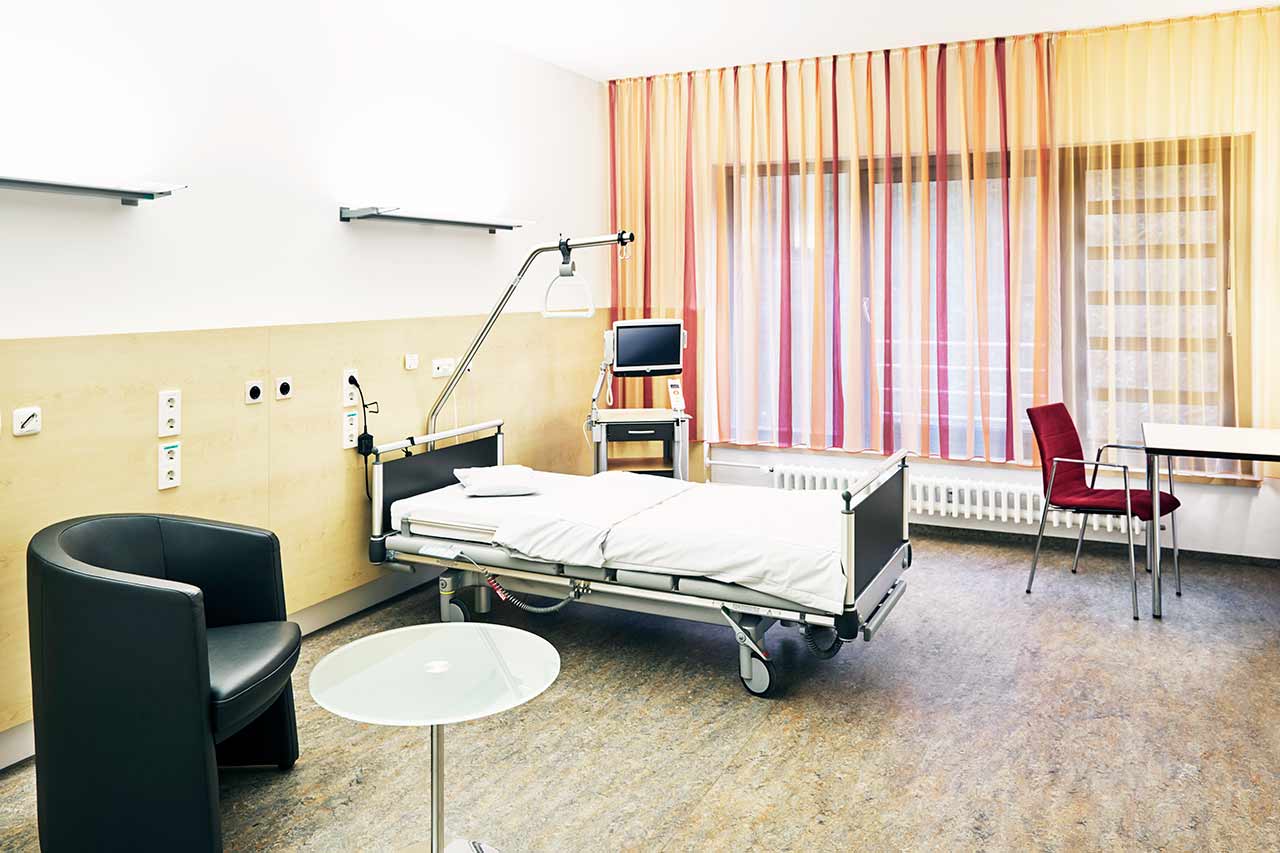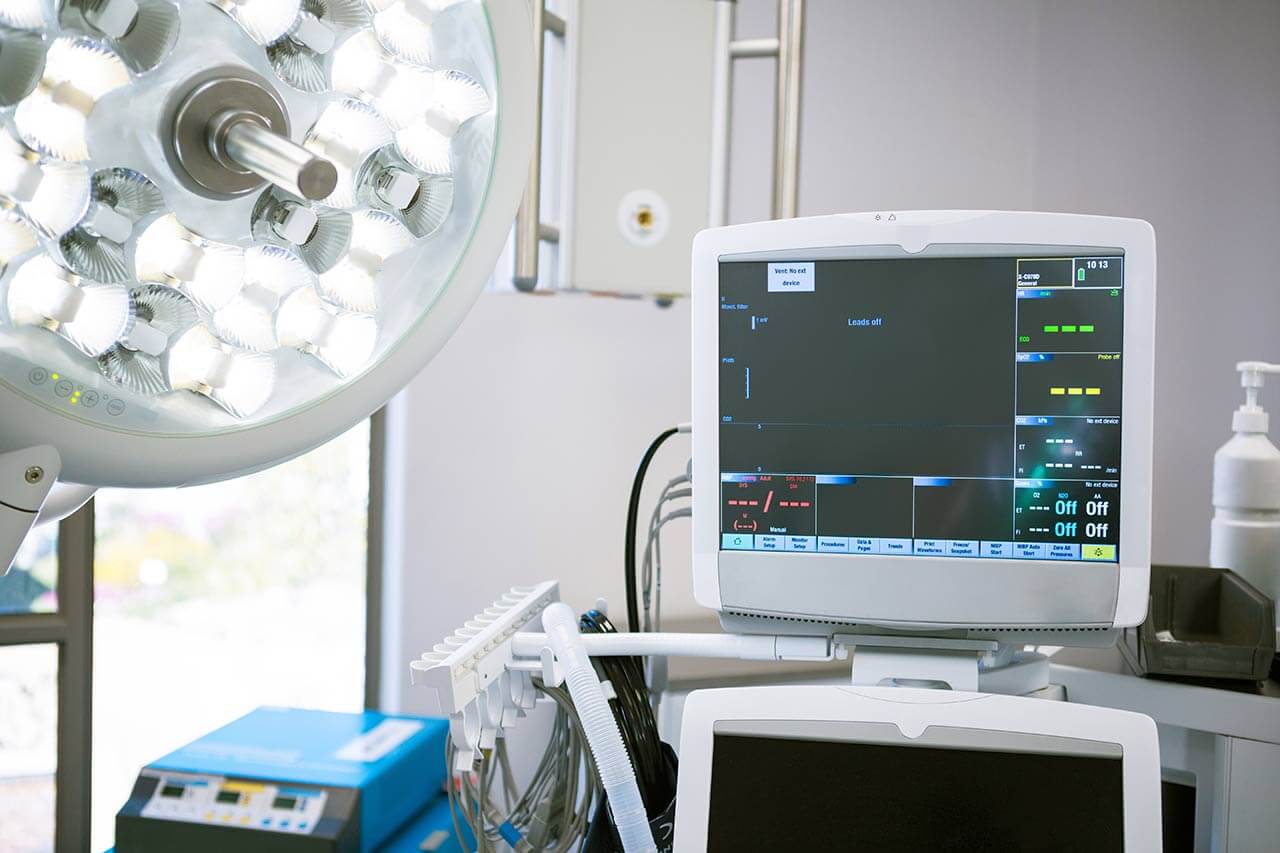
The program includes:
- Initial presentation in the clinic
- clinical history taking
- review of medical records
- physical examination
- ophthalmological examination:
- slit lamp examination
- pupil examination
- ocular motility examination
- ophthalmoscopy
- perimetry (visual field test)
- computer perimetry
- visometry (without correction and with correction)
- keratometry
- pachymetry
- refractometry (objective, subjective, cycloplegic)
- autorefractometry
- non-contact tonometry
- fluorescein angiography (if indicated clinically)
- optical coherence tomography OCT (if indicated clinically)
- gonioscopy
- photokeratoscopy
- nursing services
- services of all leading experts
- explanation of individual treatment plan
Required documents
- Medical records
Service
You may also book:
 BookingHealth Price from:
BookingHealth Price from:
About the department
The Department of Adult and Pediatric Ophthalmology at the Hospital Oberberg Gummersbach provides the full range of diagnostic services and conservative and surgical treatment of diseases of the eye and its appendages. The department has been operating successfully since 1994 and is constantly expanding its medical and technical base as well as treatment options. Of particular interest to the department's team of ophthalmologists is the treatment of cataracts and glaucoma using microsurgical techniques, surgical procedures for age-related macular degeneration, correction of strabismus in children and adults, retinal surgery, corneal transplantation, refractive surgery, and aesthetic eyelid surgery. The specialists also successfully perform laser vision correction using the LASIK technique. They have extensive experience performing phacoemulsification for cataracts using the small incision technique. Surgical interventions on the eye apparatus are performed both on an inpatient and outpatient basis. More than 3,500 surgical procedures of varying complexity are performed here every year. The department's highly professional team of ophthalmologists always works in accordance with current clinical protocols and takes into account the individual needs and wishes of each patient. The department is headed by Dr. med. Ludger Henke.
The department treats patients with cataracts on an almost daily basis. This ophthalmic pathology causes partial or total opacification of the crystalline lens, resulting in impaired vision. Without treatment, cataract patients are at risk of total blindness. The risk of developing this eye disease increases significantly between the ages of 45 and 50. Doctors treat the early stages of cataracts using drug therapy with eye drops. This allows for slowing down the pathological process for some time, but not stopping it completely. Therefore, patients with cataracts will have to undergo surgery in any case. The team of the department's ophthalmologists offers phacoemulsification, which is the most advanced surgical method for this disease. The essence of the operation is to remove the patient's own clouded lens and replace it with an intraocular lens. A surgical procedure is performed through a single microscopic incision, which contributes to the patient's rapid recovery in the postoperative period. The surgical intervention is performed using a special ultrasound system under local eye drop anesthesia. Most patients undergo surgery on an outpatient basis and can leave the clinic as early as three hours after the operation. If inpatient treatment is required, the hospital stay is usually 1-2 days.
An important area of the department's clinical activity is the treatment of retinal diseases such as age-related macular degeneration, dry and wet macular degeneration, retinal vein occlusion, diabetic retinopathy, and retinal traction detachment. When a patient is diagnosed with one of the above, the department's specialists consider possible treatment options. Most often, they choose intravitreal injections of anti-VEGF drugs. This treatment method is sparing and highly effective. Anti-VEGF therapy is usually carried out once a month. The number of procedures is prescribed on an individual basis.
The specialists of the medical facility also regularly perform laser vision correction. In particular, they offer the treatment performed with an excimer laser, LASIK. The department's ophthalmologists perform LASIK procedures for myopia (nearsightedness), hyperopia (farsightedness), astigmatism, glaucoma, secondary cataracts, and retinal diseases. The LASIK laser procedure is completely painless. It is performed under local anesthesia with eye drops on an outpatient basis. The duration of the therapeutic manipulation is 10-15 minutes.
The department's team of ophthalmologists also performs blepharoplasty (eyelid surgery). This surgical procedure is performed both for clinical indications and for aesthetic reasons. The surgeons of the medical facility operate on patients with entropion, ectropion, and hordeolum (stye). Aesthetic eyelid lifting procedures are particularly popular in the department. Blepharoplasty is performed with the use of modern laser technologies. If necessary, the surgeon can also use the laser to remove layers of muscle and fat deposits. At the end of the procedure, the patient has a natural new eyelid crease without any visible signs of lifting.
The department's clinical focuses include the following:
- Diagnostics and treatment of cataracts
- Phacoemulsification followed by intraocular lens implantation
- Diagnostics and treatment of glaucoma
- Treatment with eye drops
- Selective laser trabeculoplasty
- Diagnostics and treatment of retinal diseases
- Intravitreal injections of anti-VEGF drugs
- Diagnostics and treatment of refractive errors
- LASIK laser procedure
- Blepharoplasty (eyelid surgery)
- Blepharoplasty for entropion, ectropion, and hordeolum (stye)
- Eyelid lifting for aesthetic purposes (without any clinical indications)
- Other ophthalmic services
Curriculum vitae
Higher Education and Professional Career
- Medical studies at the Universities of Siena (Italy), Goettingen, and Muenster (Germany).
- 1987 Admission to medical practice.
- 1991 Doctoral thesis defense.
- Professional training in the Department of Ophthalmology at the University Hospital Muenster and in the Department of Ophthalmology at the Cologne-Merheim Hospital.
- 1991 Board certification and the post of a Senior Physician.
- 1994 Work in the Group Ophthalmology Practice in Erkelenz.
- 1994 Opening of the Group Ophthalmology Practice in Gummersbach and working as the Head of the Department of Adult and Pediatric Ophthalmology at the Hospital Oberberg Gummersbach.
- 1996 Launch of an outpatient surgery program in collaboration with Anesthesiology Private Practice.
- 1999 Expansion of the Ophthalmology Practice and collaboration with the Smile Eyes Zentrum, Cologne-Porz.
- 2005 Expansion of the Group Ophthalmology Practice in collaboration with Dr. Susanne Köhler.
- 2012 Foundation of the Ophthalmology Center Gummersbach.
Memberships in the Professional Societies
- Professional Association of German Ophthalmologists (BVA).
- German Society of Ophthalmology (DOG).
- Retinological Society (RG).
- German-speaking Society of Intraocular Lens Implantation, Interventional and Refractive Surgery (DGII).
- European Society of Cataract and Refractive Surgeons (ESCRS).
- Association of Ophthalmic Surgeons (VOA).
Photo of the doctor: (c) Klinikum Oberberg GmbH
About hospital
The Hospital Oberberg Gummersbach is a medical complex that offers its patients top-class personalized care. The hospital was founded in 1985. Since then, it has earned an excellent reputation in the German medical arena and has gained vast experience in the provision of medical care to foreign patients. The Hospital Oberberg Gummersbach is an academic hospital of the University of Cologne, thanks to which doctors and professors at the medical center have the opportunity to participate in promising research projects of national and international significance. The hospital has 536 beds for patient stays. The medical team consists of more than 1,400 employees. Their main focus is always on the patients and their individual needs and wishes.
The hospital has 13 departments and 7 highly specialized centers. The hospital offers various fields of modern medicine, including general and abdominal surgery, thoracic surgery, oncology, hematology, gastroenterology, nephrology, neurology, orthopedics, traumatology, gynecology, mammology, radiation oncology, otolaryngology, and others. Diagnostic and treatment facilities, as well as operating rooms at the hospital, have state-of-the-art medical equipment, including devices for imaging tests, navigation systems, equipment for endoscopic and minimally invasive interventions, and laser technologies.
Highly qualified doctors and competent nursing staff work with patients. The specialists take care of patients' health around the clock, and they are always open to personal communication and ready to provide support. The primary goal of every employee at the medical facility is to provide accurate diagnostics and the most effective treatment. At the same time, important attention is also paid to the humane and respectful attitude towards patients.
The hospital has a strict quality control system: in 2003, the medical facility was certified according to KTQ requirements, and since 2014, it has been certified according to DIN EN ISO 9001:2008 standards. The Breast Center, the Colon Center, the Oberberg Cancer Center, the Arthroplasty Center, the Stroke Unit, and many other structures of the medical facilities have been certified. Patients can thus be assured of receiving high-quality medical care using the very latest technologies.
Photo: (с) depositphotos
Accommodation in hospital
Patients rooms
The patients of the Hospital Gummersbach Oberberg stay in comfortable rooms designed in light colors. The patient rooms include an automatically adjustable bed, a bedside table with a pull-out tray, a wardrobe, a table and chairs for receiving visitors, and a TV. The hospital has access to Wi-Fi. Each patient room has an ensuite bathroom with a shower and a toilet.
The hospital also offers enhanced-comfort rooms. These patient rooms have a refrigerator, a safe, and upholstered furniture. The bathroom includes a hairdryer, a bathrobe, toiletries, and towels.
Meals and Menus
The patient and the accompanying person are offered a daily choice of three menus. If, for some reason, you do not eat all the foods, you will be offered an individual menu. Please inform the medical staff of your food preferences prior to treatment.
Further details
Standard rooms include:
Accompanying person
The accompanying person may stay with you in the patient room or at the hotel of your choice during the inpatient program.
Hotel
You may stay at the hotel of your choice during the outpatient program. Our manager will help you choose the best option.





